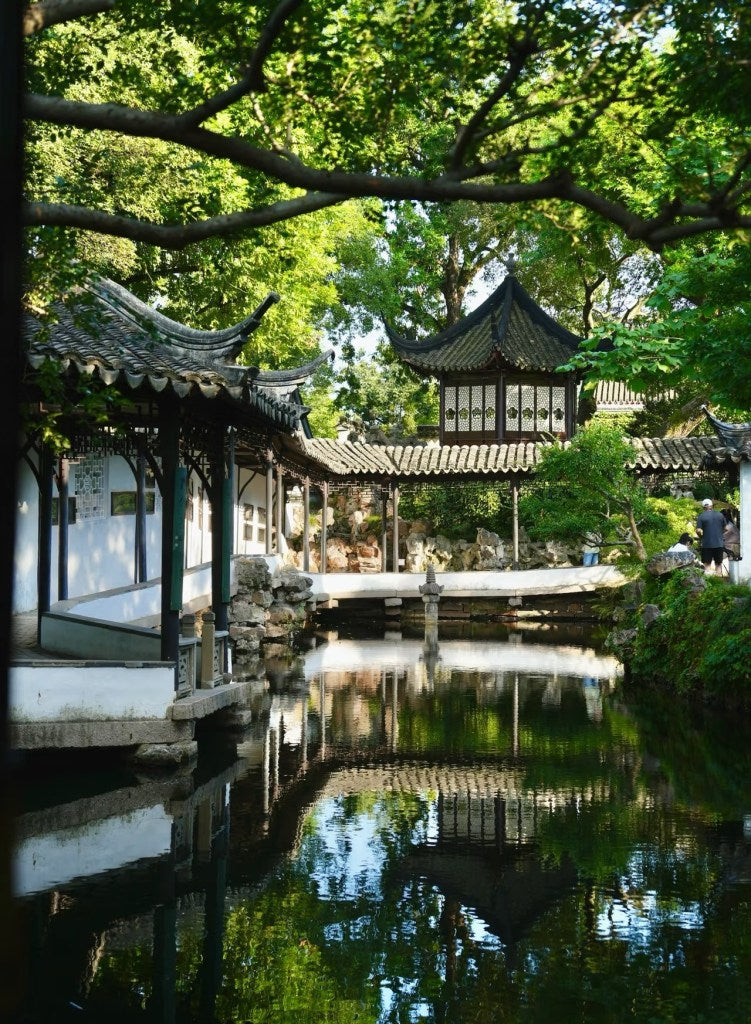
Experience the Pinnacle of Chinese Private Gardens in Just One Day
Share
1. A Millennium of Garden Wisdom, Concentrated Eastern Aesthetics
Suzhou gardens are not merely gardens; they are three-dimensional works of art that integrate architecture, landscape, poetry, painting, and philosophy. The ancients valued the principle: “Though made by man, it appears as if opened by nature,” meaning that human construction should feel naturally harmonious.
-
Borrowed Scenery (Jiejing) Technique: Cleverly using distant pagodas, hills, or trees to make a limited space feel infinitely extended (e.g., the Beisi Pagoda borrowed in the Humble Administrator’s Garden).
-
Step-by-Step Views: Every few steps, window frames and doorways form a new picture, truly embodying the concept of “changing scenery with every step.”
2. The “Spiritual Paradise” of Literati and Scholars
Most Suzhou gardens were built by retired officials or scholars dissatisfied with officialdom, who sought solace in nature and created an ideal world within a small space.
-
Lingering Garden: Built by Xu Taishi, who was disappointed in politics, as an expression of his desire for seclusion.
-
Wangshi Garden: Its name derives from “Yu Yin” (fisherman’s seclusion), symbolizing the owner’s longing for a free, simple life like a fisherman.
3. Meticulous Detail, Imitated by Emperors
Even the Jiangnan-style landscapes of Beijing’s Summer Palace and Chengde Mountain Resort drew inspiration from Suzhou gardens!
-
Taihu Stones: Slim, wrinkled, perforated, and translucent stones (e.g., the Guanyun Peak in Lingering Garden) were once imperial tributes.
-
Floral Window Patterns: No two are alike, symbolizing good fortune (e.g., the “cracked ice” pattern in the Lion Grove Garden represents resilience).
4. Living Cultural Heritage
Some gardens remain privately preserved for descendants (e.g., Huanshou Mountain Villa), while others like the Humble Administrator’s Garden and Canglang Pavilion are open to the public but still retain the purest classical charm.
-
Humble Administrator’s Garden: The ultimate expression of water-town scenery, often called the “Mother of Gardens.” Water features occupy one-third of the garden, making a stroll feel like wandering through a Venetian water town.
-
Yuangxiang Hall: Uses borrowed scenery from the Beisi Pagoda, a technique similar to the Qingyun Pavilion in Malacca.
1. A Millennium of Garden Wisdom, Concentrated Eastern Aesthetics
Suzhou gardens are not simply gardens; they are three-dimensional works of art that integrate architecture, landscape, poetry, painting, and philosophy. The ancients valued the principle: “Though made by man, it appears as if opened by nature,” meaning human construction should feel naturally harmonious.
-
Borrowed Scenery (Jiejing) Technique: Cleverly using distant pagodas, hills, or trees to make a limited space feel infinitely extended (e.g., the Beisi Pagoda borrowed in the Humble Administrator’s Garden).
-
Step-by-Step Views: Every few steps, window frames and doorways form a new picture, truly embodying the concept of “changing scenery with every step.”
2. The “Spiritual Paradise” of Literati and Scholars
Most Suzhou gardens were built by retired officials or scholars dissatisfied with officialdom, who sought solace in nature and created an ideal world within a small space.
-
Lingering Garden: Built by Xu Taishi, who was politically disappointed, as an expression of his desire for seclusion.
-
Wangshi Garden: Its name derives from “Yu Yin” (fisherman’s seclusion), symbolizing the owner’s longing for a free, simple life like a fisherman.
3. Meticulous Detail, Imitated by Emperors
Even the Jiangnan-style landscapes of Beijing’s Summer Palace and Chengde Mountain Resort drew inspiration from Suzhou gardens!
-
Taihu Stones: Slim, wrinkled, perforated, and translucent stones (e.g., Guanyun Peak in Lingering Garden) were once imperial tributes.
-
Floral Window Patterns: No two are alike, symbolizing good fortune (e.g., the “cracked ice” pattern in Lion Grove Garden represents resilience).
4. Living Cultural Heritage
Some gardens remain privately preserved for descendants (e.g., Huanshou Mountain Villa), while others like the Humble Administrator’s Garden and Canglang Pavilion are open to the public but still retain the purest classical charm.
-
Humble Administrator’s Garden: The ultimate expression of water-town scenery, often called the “Mother of Gardens.” Water features occupy one-third of the garden, making a stroll feel like wandering through a Venetian water town.
-
Yuanxiang Hall: Uses borrowed scenery from the Beisi Pagoda, a technique similar to that of Qingyun Pavilion in Malacca.


